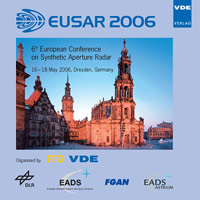A Method for Optimal GMTI Focussing and Enhanced Visual Evaluation
Conference: EUSAR 2006 - 6th European Conference on Synthetic Aperture Radar
05/16/2006 - 05/18/2006 at Dresden, Germany
Proceedings: EUSAR 2006
Pages: 4Language: englishTyp: PDF
Personal VDE Members are entitled to a 10% discount on this title
Authors:
Eineder, Michael; Bamler, Richard; Suchandt, Steffen (DLR, Germany)
Abstract:
Ground moving target indication (GMTI) from spaceborne SAR data has been successfully demonstrated by the authors with data from the Shuttle Radar Topography Mission: signatures could be assigned to larger vehicles on highways and their velocity could be estimated. In consequence of these results, a number of systematic experiments were conducted with DLR’s airborne SAR ESAR in preparation for the German satellite TerraSAR-X to be launched in 2006. Future SAR satellites like the TerraSAR-X and the Canadian Radarsat-2 will offer advanced imaging modes optimized for GMTI, e.g. using split antennas and dual or triple receive channels. Currently, an operational GMTI processing system is being developed at DLR in order to generate traffic information for civilian use from TerraSAR-X data. This paper proposes solutions for two problems occurring in such a processing and evaluation chain: Firstly, optimal SAR focussing of moving targets is not straightforward since the target motion changes the synthetic aperture parameters which have to be precisely adapted in the SAR processor. If not adapted, the target appears unfocussed and ambiguous. Secondly, moving objects appear displaced from the stationary clutter in the image making the evaluation by a human interpreter difficult. Both problems are solved simultaneously by a rigorous modelling of the imaging process and by incorporating apriory knowledge in the processing and evaluation chain. The results will be optimally focussed GMTI images that can be easily evaluated by a human operator.


